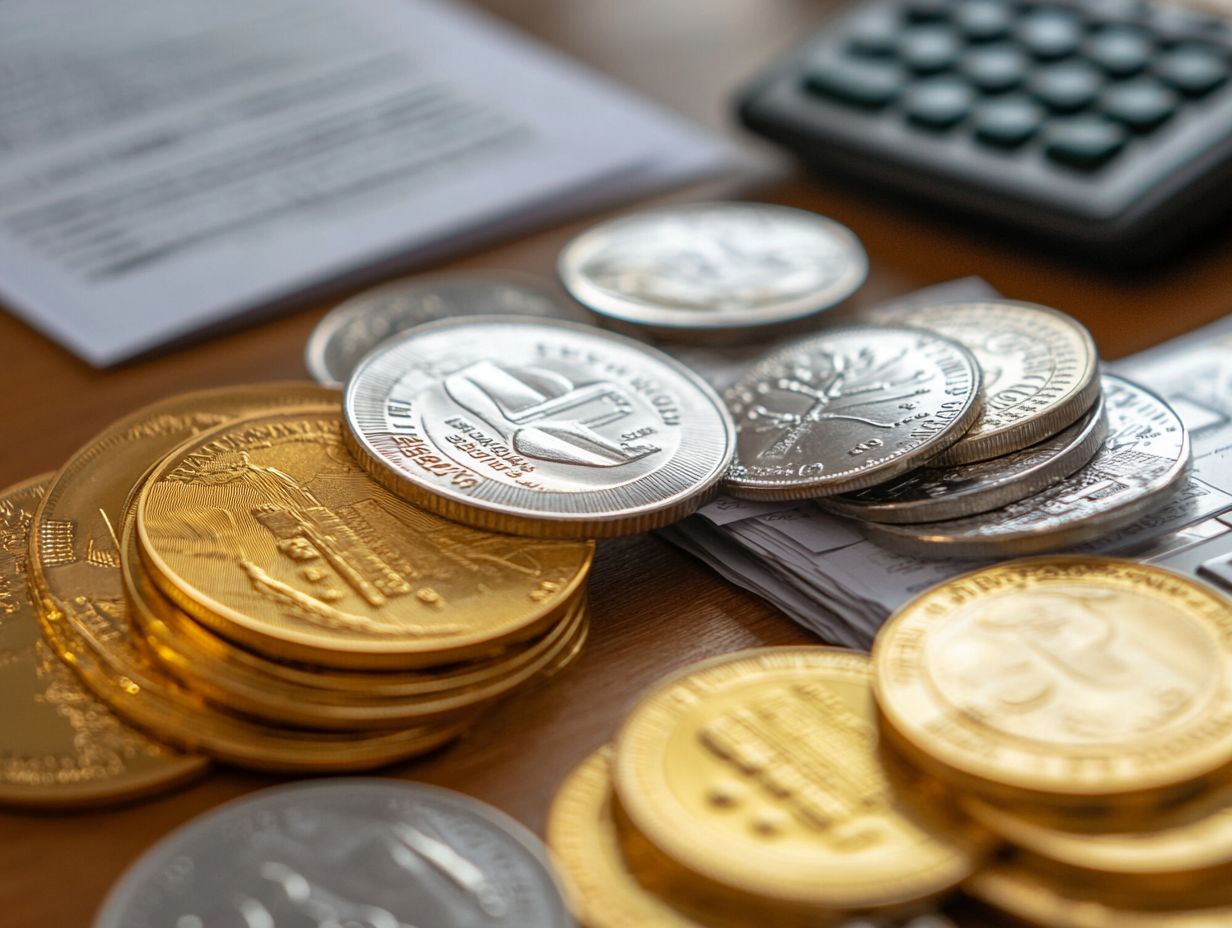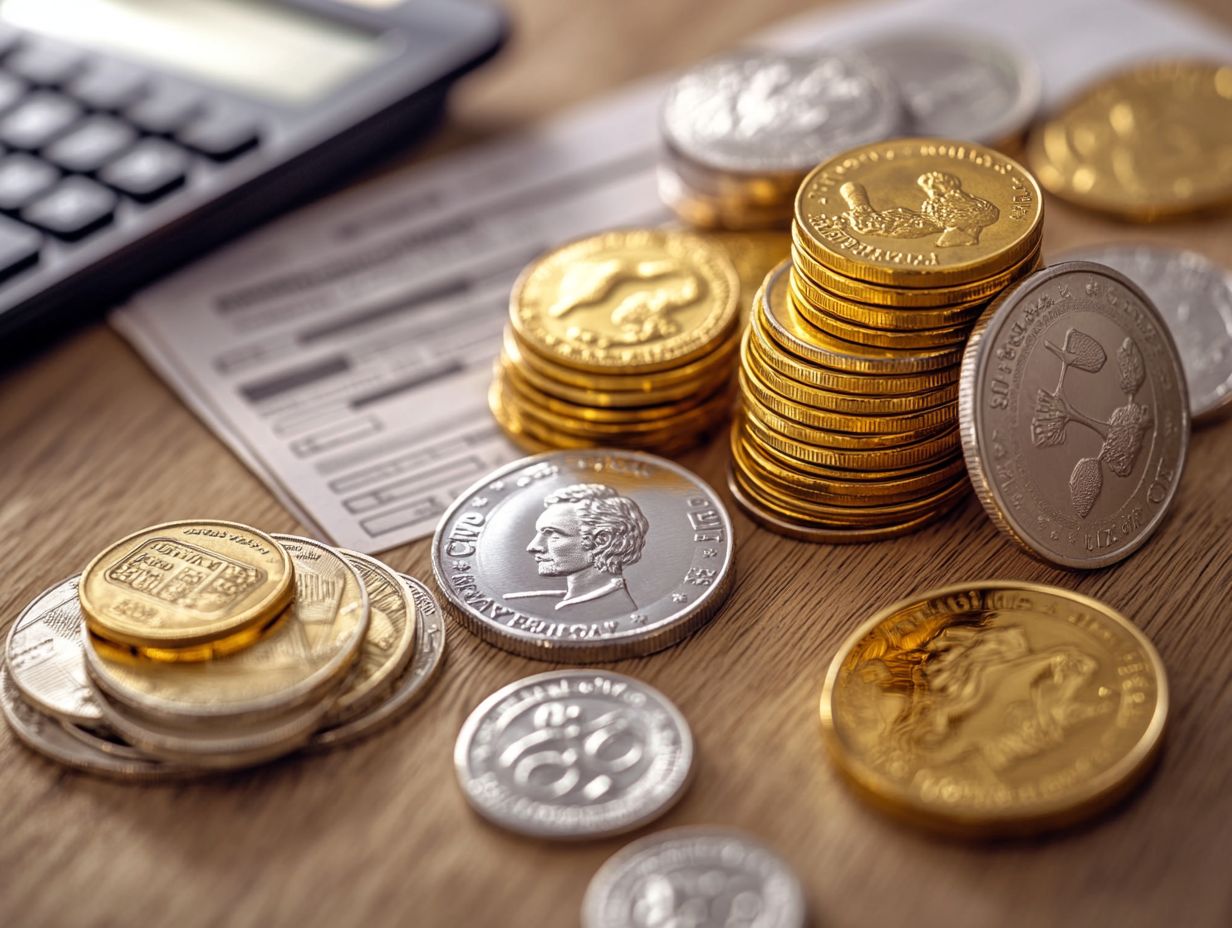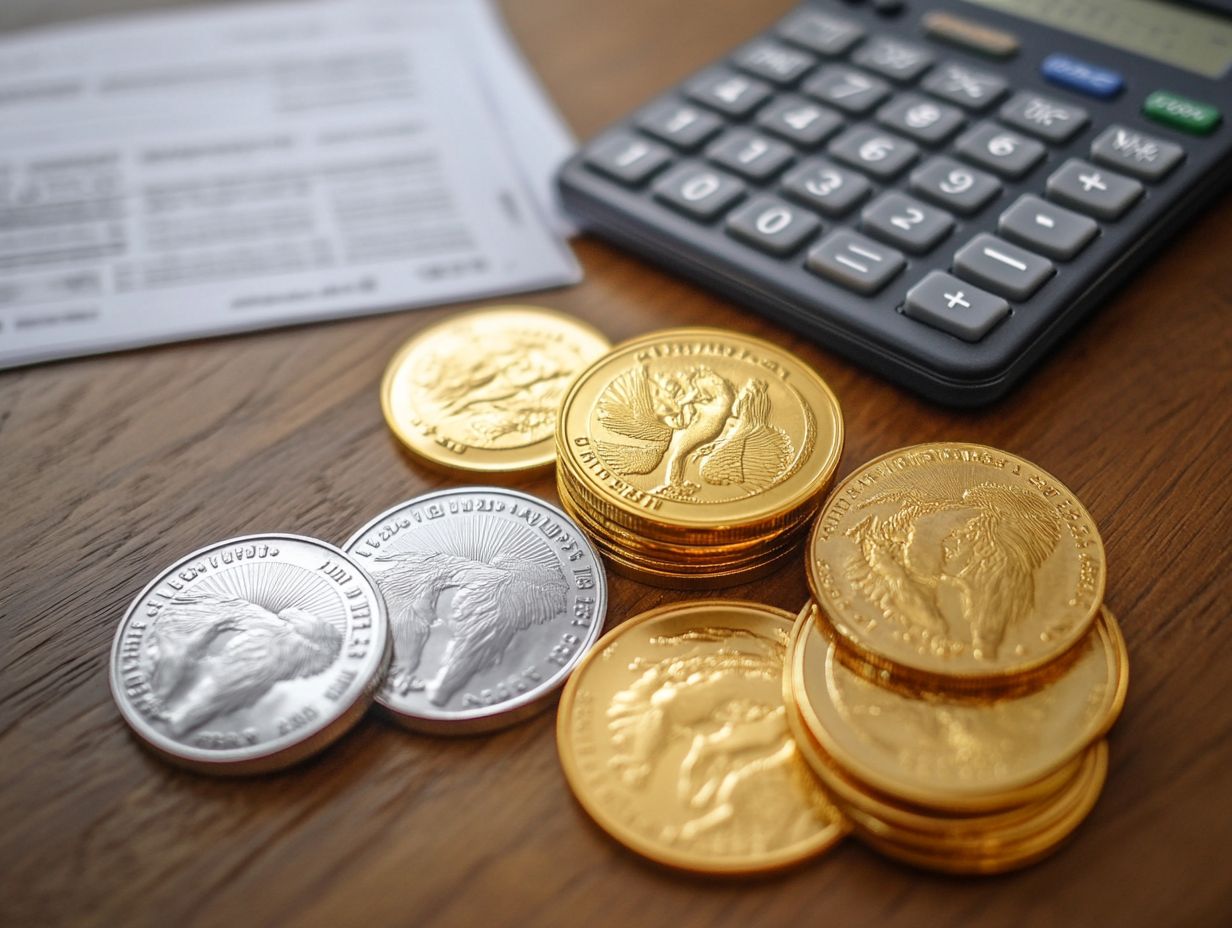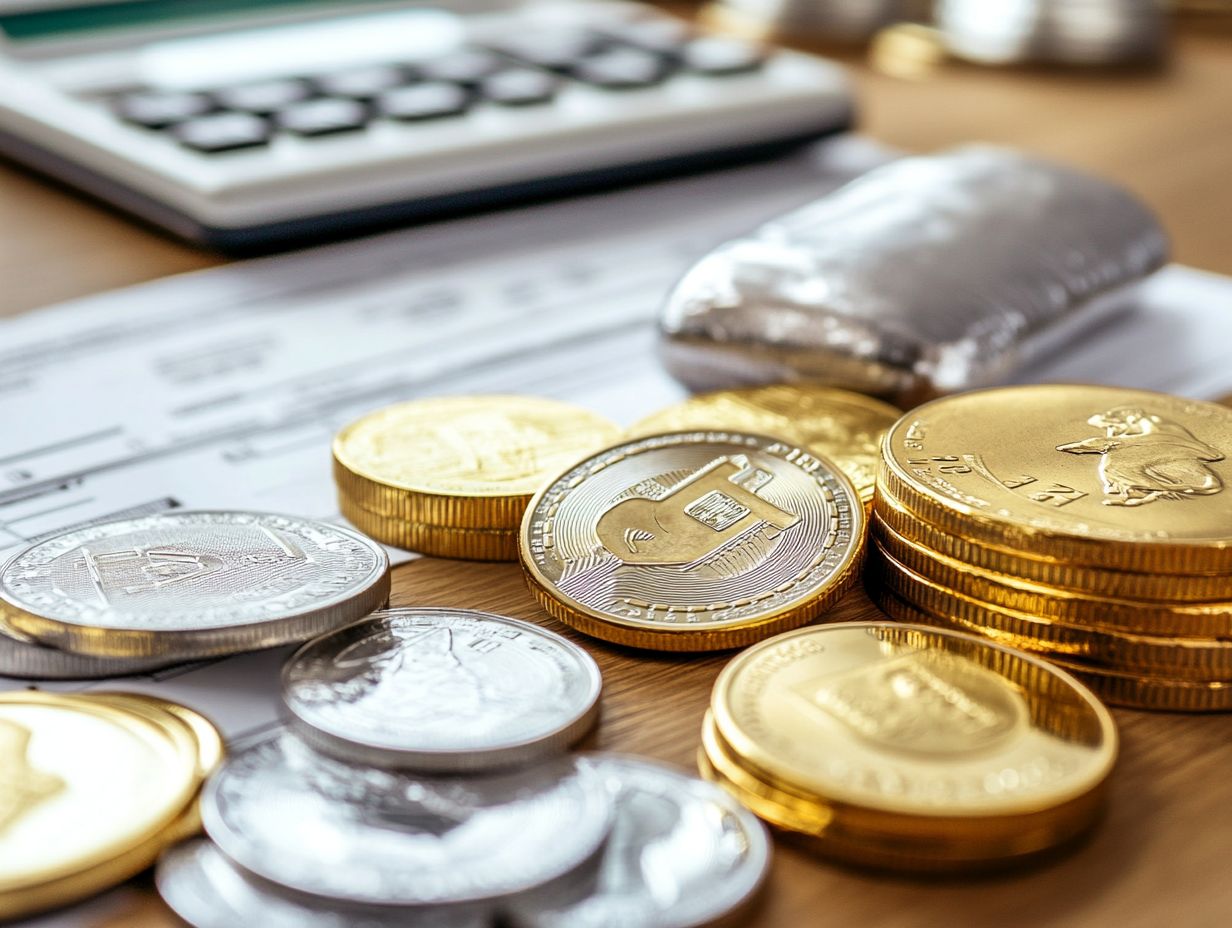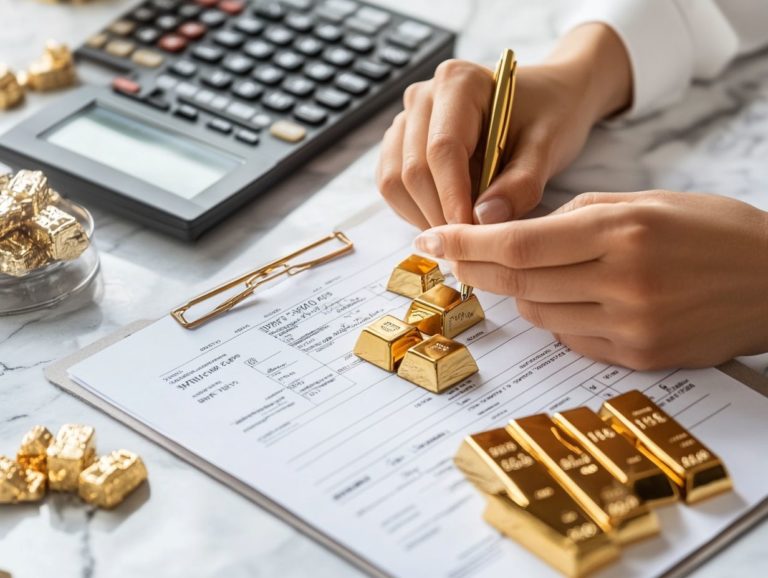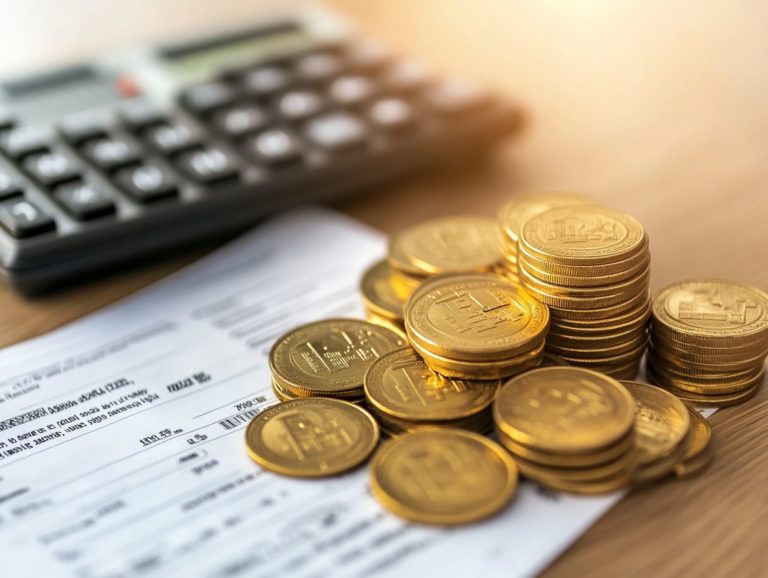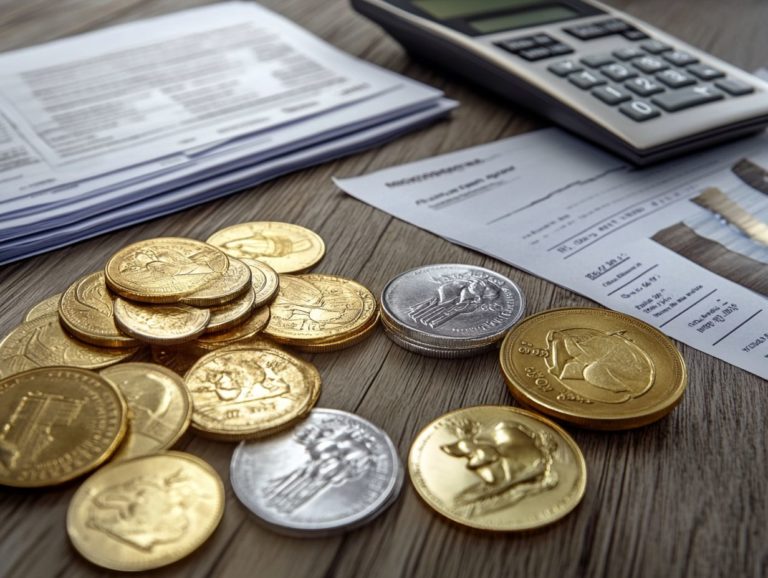Understanding Tax Credits Related to Precious Metals
Tax credits can be a powerful asset for you as an investor, particularly when dealing with precious metals like gold and silver.
This article delves into the various types of precious metals that qualify for tax credits. It outlines the eligibility requirements and the steps necessary to claim these credits.
You’ll also find insights on the benefits of investing in precious metals from a tax viewpoint, the potential risks involved, and crucial tax-related considerations. This includes reporting and record-keeping practices.
Discover how to enhance your investment strategy while skillfully navigating the intricate tax implications that come with it.
Contents
- Key Takeaways:
- What are Tax Credits?
- Types of Precious Metals Eligible for Tax Credits
- How to Claim Tax Credits for Precious Metals
- Benefits of Investing in Precious Metals for Tax Purposes
- Potential Risks of Investing in Precious Metals
- Other Tax-Related Considerations for Precious Metals
- Frequently Asked Questions
- What are tax credits related to precious metals?
- Who is eligible for tax credits related to precious metals?
- What types of precious metals qualify for tax credits?
- How much tax credit can I receive for investing in precious metals?
- Do I need to report tax credits related to precious metals on my tax return?
- Are there any risks associated with investing in precious metals for tax credits?
Key Takeaways:
- Understand how tax credits work and how they can benefit your investment in precious metals.
- Not all precious metals are eligible for tax credits, so research which ones qualify before making an investment.
- Claiming tax credits for precious metals requires meeting eligibility requirements and following the correct process for reporting and record-keeping.
What are Tax Credits?
Tax credits serve as valuable reductions in the amount of tax you owe to the government. They are often designed to incentivize particular behaviors, such as investing in qualifying assets or engaging in activities considered beneficial to the economy.
These credits can dramatically influence your overall tax liability, particularly in the context of precious metals investments.
Understanding the relationship between gains from selling investments and potential deductions is essential for optimizing your returns. This is especially true when you’re navigating the world of collectibles like gold and silver.
Types of Precious Metals Eligible for Tax Credits
A variety of precious metals qualify for tax credits, offering significant financial benefits as an investor. You can explore options like gold coins, including the American Gold Eagle and the Canadian Gold Maple Leaf.
Silver enthusiasts might gravitate toward the American Silver Eagle, while platinum and palladium also present valuable opportunities. Incorporating these metals into your investment portfolio can enhance its diversification and robustness.
Gold, Silver, and Other Metals
Gold, silver, and other metals are not just shiny trinkets; they serve as valuable investments and assets eligible for various tax credits. This is due to their status as investment-grade materials and collectibles.
You might consider bullion coins like the Gold Krugerrand and U.S. 90% silver dimes as key components of your investment strategy. These precious metals offer unique market dynamics.
Investors trust these metals as reliable safe havens during economic storms. When stock markets become volatile, savvy investors often turn to precious metals for stability, as historical trends show a strong correlation between market downturns and rising gold and silver prices.
Tax implications can differ based on how you hold your investment. Certain bullion coins benefit from favorable treatment, making them even more enticing. The allure of investment-grade status signifies a higher level of quality and liquidity, allowing you to capitalize on tax credits and additional potential returns. This ultimately reinforces your position in a well-diversified investment portfolio.
How to Claim Tax Credits for Precious Metals
Claiming tax credits for precious metals involves a meticulous process. You need to gather proper documentation and adhere to IRS guidelines. These factors could save you money, so don’t overlook them!
You must accurately report your investments, along with any associated gains or losses, on the appropriate forms—specifically, Form 1040 and Schedule D—to qualify for the available tax benefits.
This attention to detail is essential for maximizing your potential savings.
Eligibility Requirements and Process
Eligibility requirements for claiming tax credits on your precious metals investments can shift depending on specific IRS guidelines and the makeup of your investment portfolio. You must thoroughly assess your holdings to ensure compliance with reporting standards and documentation. This assessment maximizes your potential tax benefits.
Understanding the precise criteria is crucial, as these tax credits encourage investments in tangible assets like gold, silver, platinum, and palladium. Specific thresholds and conditions apply, including the weight and fineness of the metals, which must meet IRS specifications.
Maintaining accurate records is essential. You should meticulously document your purchases, sales, and any relevant transactions. This information is vital for proving you qualify when it’s time to file your taxes. Aligning your investments with IRS standards protects you from penalties and boosts your chances of receiving the tax incentives you deserve.
Benefits of Investing in Precious Metals for Tax Purposes
Investing in precious metals presents you with several significant advantages, especially regarding tax considerations. The long-term capital gains associated with these assets can occasionally be tax-free under specific conditions. This offers a unique opportunity for financial optimization.
This strategy also aids in wealth preservation and allows you to effectively reduce tax liabilities while taking advantage of the increasing market value of assets such as gold and silver.
Tax Advantages and Potential Returns
The tax advantages associated with investing in gold, silver, and other precious metals can lead to substantial potential returns. This is particularly true when you structure your investments strategically to optimize capital gains tax outcomes. These benefits position precious metals not only as a hedge against inflation but also as an appealing choice for enhancing your financial portfolio.
If you’re keen on maximizing your investments, utilizing a self-directed IRA to hold these assets is a particularly astute decision. By opting for this route, you can defer taxes until withdrawals are made, allowing your investments to grow without immediate tax implications.
You can leverage long-term capital gains, typically taxed at a lower rate, by selling your precious metals after a year or more of ownership. This dual strategy—strategic holding paired with a favorable tax structure—can significantly amplify your returns. Making informed choices is essential as you navigate the complexities of the tax landscape.
Potential Risks of Investing in Precious Metals
Investing in precious metals like gold and silver offers numerous advantages, but it also comes with potential risks. You need to be mindful of market volatility and the fluctuations in tax liability, which can occasionally trigger ordinary income taxation in specific situations.
Navigating these challenges carefully is crucial for your success! Ensure that your investment strategies remain both sound and profitable.
Market Volatility and Other Considerations
Market volatility is a vital factor for you to consider when investing in precious metals. It can dramatically influence both the value of your investments and the risks involved. Grasping how these fluctuations can lead to short-term gains or losses is essential for effective risk assessment and management, especially if you’re heavily invested in gold, silver, and similar assets.
A variety of factors contribute to this volatility, including macroeconomic indicators, geopolitical tensions, and shifts in currency values. For example, changes in interest rates can significantly impact demand for these metals, while global economic conditions may trigger sharp price movements.
You must employ robust risk assessment methodologies, such as scenario analysis and value-at-risk models, to understand potential downturns. Implementing strategies like diversifying across different assets and utilizing stop-loss orders can help mitigate the impact of sudden market shifts.
By having a clear understanding of these dynamics, you empower yourself to make informed decisions and effectively navigate the complexities of the precious metals market.
Ready to take the next step in your investment journey? Start exploring your options today!
Other Tax-Related Considerations for Precious Metals
Investing in precious metals comes with several tax-related considerations. You must pay attention to reporting requirements and track your investment’s cost basis, which is the original value of your investment.
Form 1099-B is crucial in this reporting process. Understanding dealer premiums, which are the additional costs charged by sellers, is essential for accurately calculating your potential gains and losses.
Reporting and Record-Keeping Requirements
Proper reporting and record-keeping are vital for investors in precious metals. The IRS requires specific documentation for accurate tax reporting on forms like Form 1040.
Good record-keeping helps meet IRS obligations and provides insights into your portfolio’s performance. Keep detailed records of your purchases, sales, appraisals, bank statements, and invoices.
Essential documentation includes receipts and transaction history. This is crucial if the IRS asks for more information to validate your reported income or capital gains.
Using forms like Schedule D to report capital gains and losses highlights the importance of diligent documentation. This safeguards you against potential penalties and enhances your understanding of market dynamics involved in precious metals investments.
Frequently Asked Questions
Tax credits for precious metals are government incentives encouraging investment in metals like gold and silver. These credits can lower the amount of taxes owed.
Individuals and businesses that invest in qualifying precious metals can receive tax credits. Eligibility criteria may vary by program.
What types of precious metals qualify for tax credits?
Gold, silver, platinum, and palladium coins and bars meeting certain purity standards generally qualify for tax credits. Some programs may also include metals like rhodium or iridium.
How much tax credit can I receive for investing in precious metals?
The tax credit amount depends on the specific program. It could be a percentage of your total investment or a fixed dollar amount.
Yes, you must report any applicable tax credits on your tax return. This includes both federal and state returns to avoid penalties.
Are there any risks associated with investing in precious metals for tax credits?
Investing in precious metals involves potential risks, just like any investment. Research the tax credit program and the market before investing, and consider consulting a financial advisor for personalized advice.




